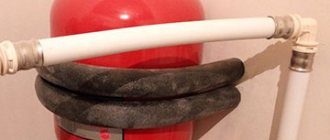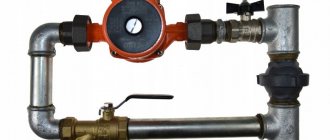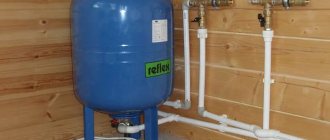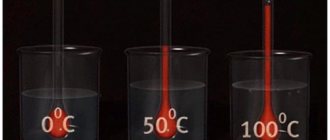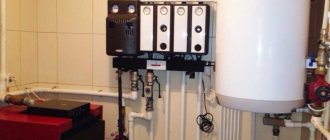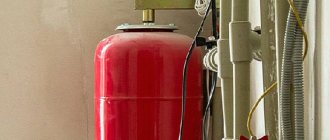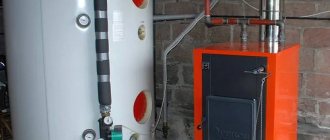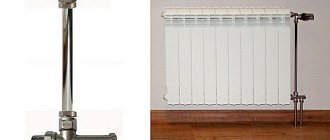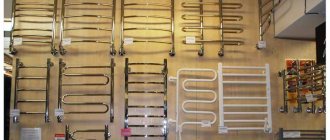To provide the coolant with the opportunity to expand when heated, it is necessary to install an expansion tank in the heating system. This is a very important event. It will protect pipes and radiators from unnecessary loads and significantly increase the service life of the functional elements of the autonomous heating system.
We will talk about how the expansion tank works in open and closed circuits. We'll show you how to install it correctly in both versions of the system. In our article you will find a description of the technology for connecting this backup capacity and useful recommendations.
Features of a heating system with an expansion tank
The heating system can be closed or open. The choice of location of the expansion tank depends on the type.
Open systems have long been outdated and at this time they can only be found in old buildings. Here the expansion tank is an open top tank. The bottom of the container is equipped with a threaded connection to which pipes are connected.
- The membrane system is equipped with a tank with a closed top.
- By design, it is a sealed capsule, inside of which there is a membrane made of durable rubber.
- This device can be installed anywhere.
It must be taken into account that it cannot be placed close to the circulation pump. Otherwise, it is likely that pressure surges will occur throughout the heating system.
Types and functions of heating expanders
An expansion tank is needed to compensate for the effect that an increase in the volume of coolant during heating has on the heating system. An additional container connected to the circuit becomes a storage place for the resulting excess water. When the temperature drops, part of the coolant leaves the tank and returns to the pipes.
The process is repeated with each heating and cooling cycle. If there was no such reservoir in the system, then when the water inside the pipes was heated, the pressure would increase and then decrease.
Such differences negatively affect the state of the system. They lead to leaks at the junctions of devices and pipes and can even cause equipment failure.
A membrane heating tank is usually installed in a boiler room. A suitable location is on the return line between the pump and the heating device
The expansion tank is selected depending on the characteristics of the heating system. For closed circuits, you need a special closed capsule with a membrane, and for open circuits, an unsealed container of a convenient configuration and the required size is suitable.
You should choose a membrane tank that is designed for contact with hot water. Typically, the body of such devices is painted red. You can make a container for installation in an open circuit yourself, for example, weld it from sheet metal. But it is important not only to choose the right device, but also to install it correctly.
For closed heating systems, containers with a membrane are used as an expansion tank, which allows the coolant to be stored under a certain pressure
Open type
Open type expansion tanks are installed at the highest point of the system. Often the location of the tank is chosen to be in the attic.
In addition to the fact that the device prevents the expansion of the coolant in the pipes, it also serves to prevent boiling of the coolant, and also replenishes its reserves in cases of leaks.
Models of the Zilmet OEM-Pro series
This expansion tank for the heating system usually receives positive reviews. Many buyers praise it for its durable body. The device also uses a good fuse. Only one membrane is used at the tank. If you trust the experts, it wears off slowly. It is recommended to install the model behind the radiator grille.
It is also worth noting that the modification is not afraid of high temperatures. A maximum of 10 liters of coolant is allowed. The air chamber is used with a small volume. The outlet valve in the device is designed for heavy loads. The maximum pressure indicator is at least 2 Pa. It is recommended to connect the thermostat behind the counter above the mixer. The modification is great for gas boilers. The price for it fluctuates around 1,700 rubles.
Circulation
The tank can be installed in systems with natural or forced circulation.
- With natural circulation, the device should be built into the main line, thanks to which it will additionally serve as an air collector;
- With forced circulation, the device is connected to the return pipe so that the water does not boil in the system.
Leak search
As we already understood, if there is no tightness, there will be a sharp loss of pressure. Of course, it is necessary to conduct a full inspection of the system to identify all problems. The main thing here is not to rush!
The best thing is that leaks can be seen quite quickly, since in places where there are leaks there will be accumulations of moisture or a white coating.
During the inspection, you need to inspect everything very carefully, without rushing. It is especially worth paying attention to the connection points. So, for example, pipes made of metal are more likely to leak at the seams. You have found the leak, but what to do next? We need to start fixing this problem.
How does this happen? The detected leakage area is repacked, new gaskets and seals are installed. Be sure to install new parts a little thicker than the previous ones. If it turns out that the pipeline is severely damaged, then it is worth replacing with a new one.
Connection system
Essentially, an open-type expansion tank is a container with four pipe outlets:
- Circulating;
- Expansion;
- Overflow;
- Signal purpose.
The heating system is connected to an expansion pipe located on top of the tank. An overflow is needed to drain water into the sewer when the tank overflows.
At the bottom there is a signal pipe with a locking device. Circulation is necessary to permanently maintain the overall temperature, in order to avoid freezing of the coolant in the tank.
Expansion tank problems
One of the reasons for the drop in pressure may be a breakdown of the expansion tank. There are two reasons for this: wear of the membrane and damage to the chamber. It is not very difficult to detect a breakdown in the tank: you need to press on the nipple. If air comes out and a characteristic sound is made, then the tank is in good condition. If water comes out, it is necessary to replace the membrane or the expansion tank itself.
You should not try to glue the membrane, because in the process of constant compression and stretching, the hole will appear again. There is a boiler with a built-in tank. In this case, there is no need to look for components for boiler equipment; it is easier to install an external tank and install a plug on the old one.
We recommend: How do we carry out heating repairs in a private home?
Minuses
Recently, such products are not used in heating systems, as they have many disadvantages. Among them the following can be noted:
- Cannot withstand high pressure;
- The design is quite bulky and has large dimensions;
- Air penetrates into the open system along with the coolant, which has a negative effect on the surface of the metal elements, which causes pockets of corrosion to appear - corrosion will soon form on them;
- Such a device must be installed at the highest point of the system, which incurs additional costs.
Calculation example
The example below shows how to choose an expansion tank for heating a cottage with the following parameters:
- total area – 180 sq. m.;
- number of floors – 3;
- ceiling height – 2.5 m;
- coolant – water with the addition of ethylene glycol 20%;
- working pressure – 2.5 atm;
- maximum temperature – no more than +80C.
Calculation of expansion tank volume:
- set the total height of the heated premises: 3 * 2.5 = 7.5 m;
- the compensating pressure will be: dB = 7.5 * 0.1 = 0.75 atm;
- determine efficiency: E = (2.5-0.75)/(2.5+1) = 0.5;
- to heat such a building you will need a boiler with a capacity of 18 kW (one kW for every 10 sq. m of area);
- without precise measurement, you can set the approximate amount of coolant as follows: 18*15=270;
- Substituting the values into the formula, calculate the volume of the expansion tank for heating: O = (270*0.0349)/0.5 = 18.846 liters.
Next, we will select a suitable model from the list of current offers. It is necessary to purchase a tank with a reserve capacity in order to eliminate problems during operation.
For example, Reflex NG 25 with the following characteristics corresponds to the design parameters:
- tank volume – 25 l;
- installation method – wall;
- maximum pressure – 6 atm;
- coolant temperature – no more than +120 C;
- connection dimensions of the liner – 3⁄4 inches;
- diameter x height – 28 x 50 cm;
- empty product weight – 4 kg.
A water supply expansion tank is purchased in the same way: selection and installation comply with the above recommendations. The main difference is the use of only clean water in the transport system, so that the water supply tank is selected correctly.
The necessary expansion factors should be used during calculations. The formulas take into account the capacity of the transport system and the boiler.
The expansion tank for water supply (hot) is designed for a lower operating temperature compared to the analogue discussed above (up to +70 C). To eliminate mistakes, manufacturers use blue and red paint on the outer surface of the housing (DHW and heating, respectively).
At the same time, they increase strength to prevent damage from water hammer. Serial products can withstand an increase in pressure up to 10-12 atm.
The selection of an expansion tank for hot water is carried out simultaneously with shut-off devices, pressure gauges, and other related parts.
Closed type
The membrane expansion tank does not have all the disadvantages inherent in the system described above.
However, installing it requires some additions and rules:
- Requires a pressure gauge;
- A device for manual pressure adjustment is required, otherwise the pressure may exceed all standard tolerances;
- The tank should be installed as close to the boiler as possible and with a connection to the return pipe. This is necessary to prevent the water from boiling.
You should not ignore the reliability of the fasteners, since during operation the weight of the expansion tank can increase significantly.
About additional capacities
Manufacturers equip wall-mounted heat generators with built-in tanks that absorb excess heated coolant. The dimensions of the tank do not always correspond to the house heating wiring; sometimes the capacity is not enough. To ensure that the coolant pressure during heating is within normal limits, the displacement is calculated and an additional expansion tank is installed for the wall-mounted boiler.
For example, you converted an open gravity system into a closed one without replacing the mains. The new heating unit was selected according to the heat load. The built-in boiler tank is not enough to expand such an amount of water.
Another example: heated floor heating of all rooms of a two- or three-story house plus a radiator network. Here, the volume of coolant will also be impressive; a small tank will not be able to cope with its increase, and the pressure inside the system will increase. A second expansion tank for the boiler is needed.
Note. The second tank to help the boiler is also a closed membrane container, located in the furnace room.
When the hot water supply at home is provided by an indirect heating boiler, a similar problem arises - where to put the excess sanitary water from the storage tank? A simple solution is to install a relief valve, as is done on electric water heaters. But an indirect heating boiler with a volume of 200...300 liters will lose too much hot water through the valve. The right solution is to select and install an expansion tank for the boiler.
Reference. Buffer tanks (heat accumulators) from some manufacturers also provide the ability to connect a compensating tank. Moreover, experts recommend installing it even on large-capacity electric boilers, as shown in the video:
Design Features
By design, the expansion tank is a metal container of a flat or cylindrical shape. The inside of the tank is divided into zones by means of a rubber membrane.
One zone contains compressed gas or air.
- In the non-working position, the entire volume of the container is filled with gas.
- Before starting the system, the pressure in the tank must be the same as that of the entire heating system.
- After the temperature rises, water enters a separate zone, and in the part where the gas is located, the pressure increases to the value created in the entire system.
If there is a sufficient amount of coolant, the gas pressure requires careful monitoring. For this purpose, a special compressor is installed that maintains a certain pressure. It turns out that the main element in the tank is the membrane.
How to adjust optimal pressure
If the expansion tank is inflated correctly, the pressure gauge needle will display a smooth rise; when jumps or jerks appear, I have suspicions, which lead to additional adjustment. Without the most careful attention to manipulations, it will not be possible to achieve productive operation of the heating system.
If the exhibitor is over-pumped, the compensating functions simply will not work, and the integrity of all components will be at risk.
Excess air pushes liquid out of the reservoir, thereby creating high pressure in pipes and radiators.
Low performance will also not be beneficial, the equipment will not work at all, the membrane will be pushed out by water and the entire container will be filled with coolant.
When the liquid expands, the safety valve will operate, and the hot water system will stop working, and the device will be of no use. That is why I advise you to pay special attention to correct adjustments so as not to encounter surprises and problems.
The optimal value can be simply calculated and brought to an ideal state by bleeding off excess air. All manipulations are carried out with a cold system; 0.2 atm must be added to the initial value.
The statistical pressure can be calculated using the example of dividing by 10, let’s say my house is 8 meters high, then the formula looks like this: 8/10+0.2 atm. To equalize this indicator, air is gradually added or bleed into the tank through a special spool.
Membrane types
There are two types of membranes:
- Diaphragm, often such an element cannot be replaced with anything if it fails. This type is used more often in small-volume tanks;
- The balloon is easily replaced if it malfunctions. The coolant in such a membrane does not have contact directly with the surface of the container, because of this the service life of the product is significantly extended.
Manufacturers and prices
Currently, the problem of buying an expansion tank for heating lies only in the correct selection of the type and volume of the device, as well as the financial capabilities of the buyer.
The market offers a wide selection of instrument models from both domestic and foreign manufacturers. However, it should be noted that if the purchase price for such devices as a closed-type expansion tank for heating is much lower than that of its main competitors, then it is better to refuse such a purchase. The low cost indicates the unreliability of the manufacturer and the low quality of the materials used in its manufacture. Often these are products from China. As with all other goods, the price for a high-quality expansion tank for heating will not have a significant difference of about two to three times. Conscientious manufacturers use approximately the same materials, and the difference in price of models with similar parameters of about 10-15% is determined only by the location of production and the pricing policy of sellers. Domestic manufacturers have proven themselves well in this market segment. By installing modern technological lines in their production, they achieved the production of products whose parameters are not inferior to the best global brands at a lower cost. It should be borne in mind that it is important not only to buy an expansion tank for closed-type heating, it also requires its correct installation. Having the necessary skills and following the instructions, you can install it yourself
If the master still has any doubts about his knowledge, then it is best to turn to professionals to guarantee stable operation of the heating network and eliminate possible malfunctions
Having the necessary skills and following the instructions, you can install it yourself. If the technician still has any doubts about his knowledge, then it is best to turn to professionals to guarantee stable operation of the heating network and eliminate possible malfunctions.
DIY connection
A closed type system is more common, so it is better to familiarize yourself with the process of connecting the tank, just this option.
- First you need to decide on the capacity. It should be about a tenth of the total volume of the coolant.
- Make correct technical calculations. Particular attention should be paid to the overall volume of the heating system.
- Disconnect the boiler from the heating source. Shut off the coolant supply using the valve to connect the expansion tank.
- Completely empty the circuit of liquid.
- To connect the container to the system, you will need a special soldering iron, fasteners, and a set of tees and fittings.
It is recommended to install the tank in a place with the lowest pressure. But you need to calculate so that the expansion tank does not interfere. Despite the ease of installation, it is advisable to entrust the connection of the expansion tank and boiler to a specialist.
An expansion tank of a simple design is not that difficult to install yourself. This procedure does not require special skills or special tools.
However, it is necessary to strictly follow the recommendations relating to the characteristics of the heating system in which installation work is carried out.
Installation of membrane device
A hydraulic accumulator of this type is installed where there is a minimum probability of coolant turbulence, since a pump is used for normal circulation of water flow along the circuit.
Correct container position
When connecting the expansion tank to a closed heating system, be sure to take into account the location of the air chamber of the device.
The rubber membrane periodically stretches and then contracts. Due to this impact, microcracks appear on it over time, which gradually increase. After this, the membrane has to be replaced with a new one.
It is better to install an expansion tank with a membrane so that the air-filled compartment is on top, this will extend the life of the device
If the air chamber of such a tank remains at the bottom during installation, the pressure on the membrane will increase due to gravitational influence. Cracks will appear faster and repairs will be needed sooner.
It makes more sense to install the expansion tank in such a way that the compartment filled with air remains on top. This will extend the life of the device.
Features of choosing an installation location
There are a number of requirements that must be taken into account when installing a membrane expansion tank:
- It cannot be placed close to the wall.
- The device should be freely accessible for regular maintenance and necessary repairs.
- The wall-hung tank should not be positioned too high.
- A shut-off valve should be placed between the tank and the heating pipes, which will allow you to remove the device without completely draining the coolant from the system.
- When installing on a wall, the pipes connected to the expansion tank must also be attached to the wall in order to remove possible additional load from the tank pipe.
For a membrane device, the most suitable connection point is the return section of the line between the circulation pump and the boiler. Theoretically, it is possible to install an expansion tank on the supply pipe, but high water temperatures will negatively affect the integrity of the membrane and its service life.
When installing an expansion tank, it is necessary to provide shut-off valves that will allow you to disconnect the device from the system and drain the water from it
When using solid fuel equipment, such placement is also dangerous because steam can enter the container due to overheating. This will seriously disrupt the operation of the membrane and may even damage it.
In addition to the shut-off valve and the “American” connection, it is recommended to install an additional tee and tap when connecting, which will allow you to empty the expansion tank before disconnecting.
Setting up the device before use
Before installation or immediately after it, it is necessary to correctly configure the expansion tank, otherwise called an expansion tank. This is not difficult to do, but first you need to find out what pressure should be in the heating system. Let's say an acceptable value is 1.5 bar.
Now you need to measure the pressure inside the air part of the membrane tank. It should be less by about 0.2-0.3 bar. Measurements are carried out with a pressure gauge with a suitable gradation through the nipple connection, which is located on the tank body. If necessary, air is pumped into the compartment or excess air is vented.
Before installing the membrane tank in the heating system, check the air pressure in the air compartment and adjust it according to the requirements
The technical documentation usually indicates the operating pressure, which is set by the manufacturer at the factory. But practice shows that this is not always true. During storage and transportation, some air may escape from the compartment. You must take your own measurements.
If the pressure in the tank is not set correctly, this can lead to air leakage through the air removal device. This phenomenon causes a gradual cooling of the coolant in the tank. There is no need to pre-fill the membrane tank with coolant; simply fill the system.
Tank as additional capacity
Modern models of heating boilers are often already equipped with a built-in expansion tank. However, its characteristics do not always correspond to the requirements of a specific heating system. If the built-in tank is too small, you need to install an additional tank.
It will ensure normal coolant pressure in the system. This addition will also be relevant if the heating circuit configuration changes. For example, when a gravity system is converted into a circulation pump and the old pipes are left behind.
This is true for any systems with a significant volume of coolant, for example, in a two- or three-story cottage or where, in addition to radiators, there is a heated floor. If a boiler with a small built-in membrane tank is used, installing another tank is almost inevitable.
An expansion tank will also be appropriate when using an indirect heating boiler. A relief valve, similar to that installed on electric boilers, will not be effective here; an expansomat is an adequate way out of the situation.
